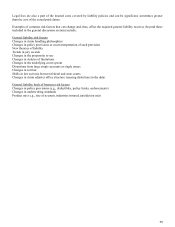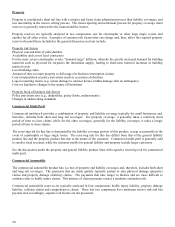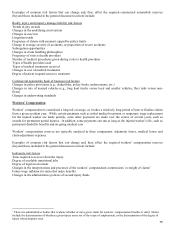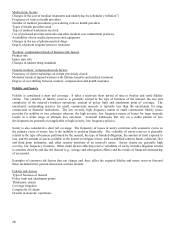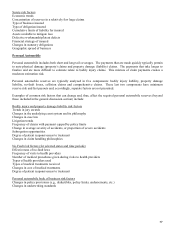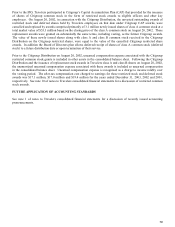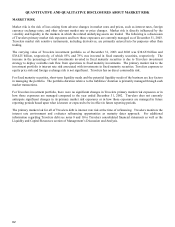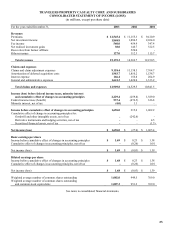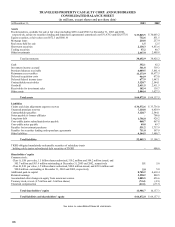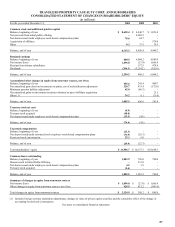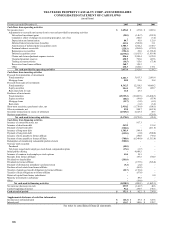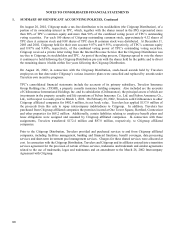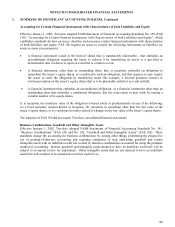Travelers 2003 Annual Report Download - page 85
Download and view the complete annual report
Please find page 85 of the 2003 Travelers annual report below. You can navigate through the pages in the report by either clicking on the pages listed below, or by using the keyword search tool below to find specific information within the annual report.83
SENSITIVITY ANALYSIS
Sensitivity analysis is defined as the measurement of potential loss in future earnings, fair values or cash flows of
market sensitive instruments resulting from one or more selected hypothetical changes in interest rates and other
market rates or prices over a selected time. In Travelers sensitivity analysis model, a hypothetical change in market
rates is selected that is expected to reflect reasonably possible near-term changes in those rates. “Near-term” means a
period of time going forward up to one year from the date of the consolidated financial statements. Actual results may
differ from the hypothetical change in market rates assumed in this disclosure, especially since this sensitivity analysis
does not reflect the results of any actions that would be taken by Travelers to mitigate such hypothetical losses in fair
value.
In this sensitivity analysis model, Travelers uses fair values to measure its potential loss. The sensitivity analysis
model includes the following financial instruments entered into for purposes other than trading: fixed maturities,
interest-bearing non-redeemable preferred stocks, mortgage loans, short-term securities, cash, investment income
accrued, fixed rate trust securities and derivative financial instruments. The primary market risk to Travelers market
sensitive instruments is interest rate risk. The sensitivity analysis model uses a 100 basis point change in interest rates
to measure the hypothetical change in fair value of financial instruments included in the model.
For invested assets, duration modeling is used to calculate changes in fair values. Durations on invested assets are
adjusted for call, put and interest rate reset features. Duration on tax-exempt securities is adjusted for the fact that the
yield on such securities is less sensitive to changes in interest rates compared to Treasury securities. Invested asset
portfolio durations are calculated on a market value weighted basis, including accrued investment income, using
holdings as of December 31, 2003 and 2002.
For debt and fixed rate trust securities, the change in fair value is determined by calculating hypothetical December 31,
2003 and 2002 ending prices based on yields adjusted to reflect a 100 basis point change, comparing such hypothetical
ending prices to actual ending prices, and multiplying the difference by the par or securities outstanding.
The sensitivity analysis model used by Travelers produces a loss in fair value of market sensitive instruments of
approximately $1.2 billion and $1.5 billion based on a 100 basis point increase in interest rates as of December 31,
2003 and 2002, respectively. This loss value only reflects the impact of an interest rate increase on the fair value of
Travelers financial instruments, which constitute approximately 57% of total assets and approximately 5% of total
liabilities as of December 31, 2003 and approximately 57% of total assets and approximately 6% of total liabilities as
of December 31, 2002. As a result, the loss value excludes a significant portion of Travelers consolidated balance
sheet which would materially mitigate the impact of the loss in fair value associated with a 100 basis point increase in
interest rates.
For example, some non-financial instruments, primarily insurance accounts for which the fixed maturity portfolio’s
primary purpose is to fund future claims payments, are not reflected in the development of the above loss value. These
non-financial instruments include premium balances receivable, reinsurance recoverables, claims and claim adjustment
expense reserves and unearned premium reserves. Travelers sensitivity model also calculates a potential loss in fair
value with the inclusion of these non-financial instruments. For non-financial instruments, changes in fair value are
determined by calculating the present value of the estimated cash flows associated with such instruments using risk-
free rates as of December 31, 2003 and 2002, calculating the resulting duration, then using that duration to determine
the change in value for a 100 basis point change.
Based on the sensitivity analysis model Travelers uses, the loss in fair value of market sensitive instruments, including
these non-financial instruments, as a result of a 100 basis point increase in interest rates as of December 31, 2003 and
2002, is not material.


